If you want to add beautiful colors and scents to your perennial garden, you might try planting graceful, easy-to-grow lilies.
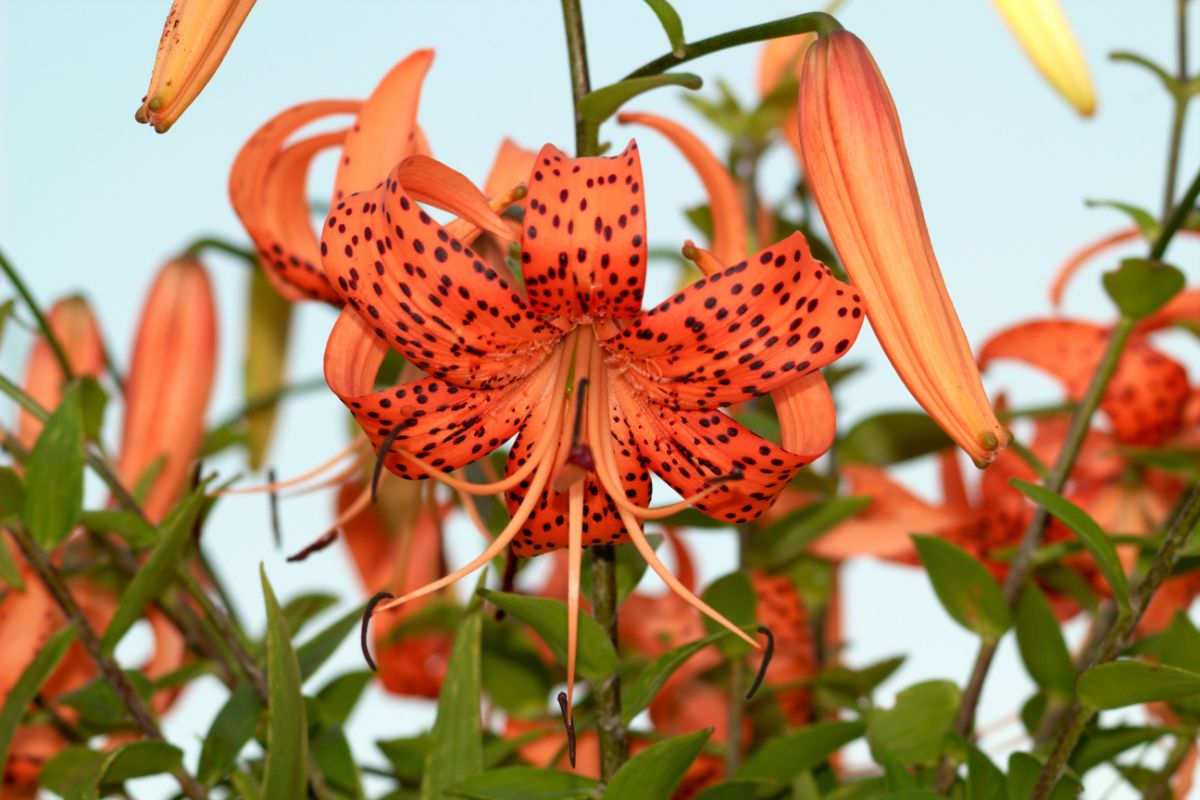
In this guide, you are going to learn how to plant and care for lilies. Note that this guide is going to focus on true lilies, not other types of lilies.
You can jump to any section quickly using the advanced jump below, or read on for the full lily grow guide.
Jump to:
- What Are True Lilies?
- What Lilies are Not True Lilies?
- Types of True Lilies
- True Lily Basics
- Where Do Lilies Grow?
- Why Grow True Lilies?
- When Do Lilies Bloom?
- How Long Do True Lilies Bloom?
- When to Plant True Lilies
- Ideal Growing Conditions for True Lilies
- How to Plant True Lilies
- How to Propagate True Lilies
- How to Care for True Lilies
- Recommended Planting Combinations for True Lily
- True Lily Landscaping Ideas
- Recommended True Lily Varieties
- Frequently Asked Questions About Growing True Lilies
- Where to Buy True Lilies
What Are True Lilies?
There are a number of different plants that we refer to as “lilies.” But true lilies are those that belong to the genus Lilium.
Lilies are popular ornamental plants, producing large, showy, elegant blooms that are as beloved for their fragrances as they are for their varied hues.
While the majority of lilies are dormant during winter, there are some lilies that are dormant during summer or fall.
A number of different types of lilies have won the Award of Garden Merit from the Royal Horticultural Society.
What Lilies are Not True Lilies?
Quite a few other plants are referred to as “lilies” that are not part of the Lilium genus. Some examples include:
• Lilies of the valley
• Daylilies
• Ginger lilies
• Cobra lilies
• Water lilies
• Fire lilies
• Calla lilies
• Lilies of the Nile
• Trout lilies
• Amazon lilies
• Peruvian lilies
• Leek lilies
• Kaffir lilies
We have put together separate guides for growing a couple of the more popular types of plants from the list above. See our Lily of the Valley Full Growing Guide as well as our Daylilies Full Growing Guide.
Types of True Lilies
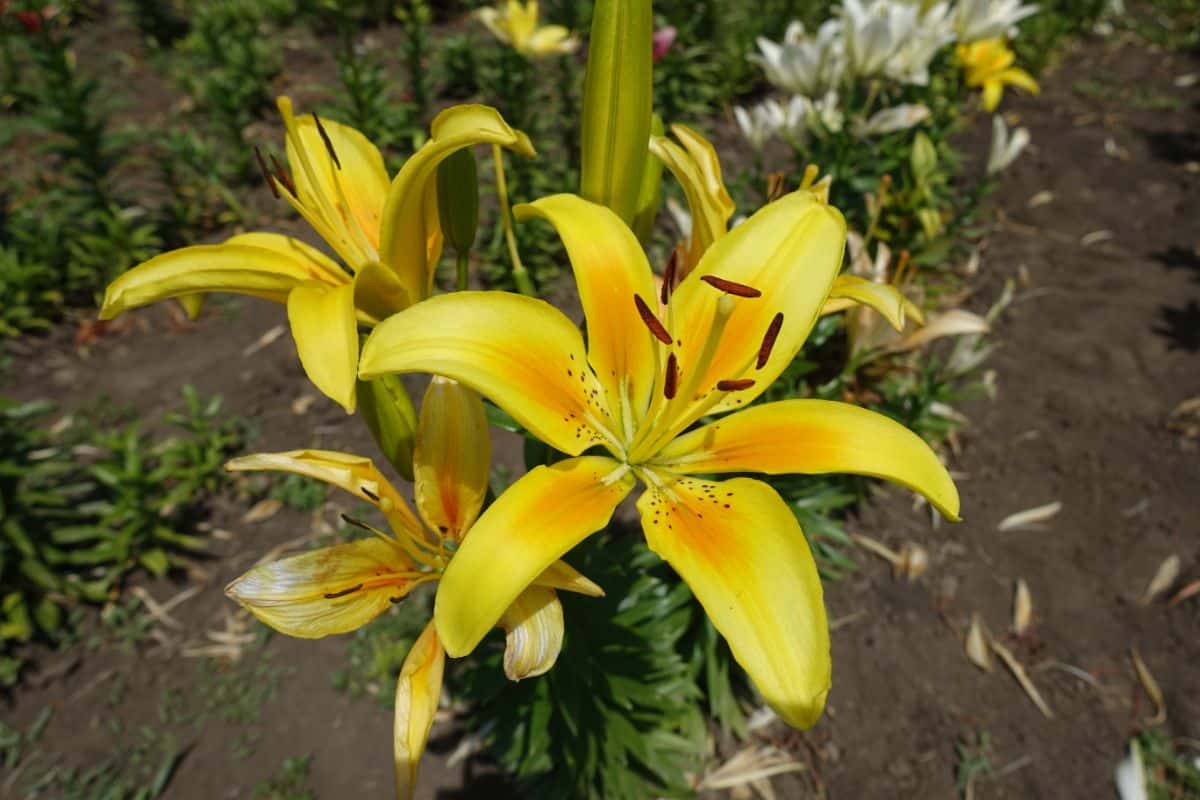
While many types of “lilies” you think of as such are actually members of other genera, quite a few lilies you are familiar with are members of the Lilium genus. Here are some popular types of true lilies:
• Easter lilies: The scientific name for Easter lilies is Lilium longifolium. The reason for their name is their bloom period, which is close to the Easter holiday. If you want to grow them as perennials outdoors, you will have an easier time doing so if you are in a relatively warm climate zone. Like poinsettias, they are popular holiday gifts, and people often discard them when they are done blooming. But this may be unnecessary, depending on where you live.
• Asiatic lilies: If you want an easy type of lily to grow that will bloom early in the growing season, consider planting Asiatic lilies. You can expect their petals to open in May or June, bringing vibrant hues to your landscape.
• Trumpet lilies: For beautiful blooms that produce a sweet fragrance, consider planting trumpet lilies. These plants take their name from the trumpet-like shape of their flowers.
• Oriental lilies: If fragrance is as much your reason for wanting to grow lilies as their colorful blooms, then you are definitely going to want to plant Oriental lilies. Another benefit of these lilies is their relatively late bloom time in comparison to Asiatic lilies. By planting some of each, you can enjoy your lilies over a longer span of the summer each year. The sturdy stems are around 4 feet tall.
• Tiger lilies: “Tiger lily” is the common name for more than one species of lily. Sometimes, this name refers to Lilium lancifolium. Other times, it refers instead to Lilium henryi. Regardless of the type of tiger lily you end up planting, you are sure to delight in the gorgeous blooms.
• Turk’s cap lilies: This is the common name for the species Lilium superbum. The University of Texas at Austin writes, “The largest and most spectacular of the native Lilies; up to 40 flowers have been recorded on a single plant. The recurved sepals and petals, which presumably resemble a type of cap worn by early Turks, and the showy extruded stamens, are distinctive features. Indians used the bulbs for soup.”
• Orienpet lilies: If you love both Oriental lilies and trumpet lilies, then you may be interested in a special type of hybrid of both called an “Orienpet” lily.
• LA lilies: For a lily that combines the best of both worlds of Easter and Asiatic lilies, think about getting the hybrid “LA” lily.
This is just a list of a few types of true lilies. There are plenty of other members of the Lilium genus to fall in love with in your summer garden.
True Lily Basics
| Zones: | 4-9 |
| Blooming season: | Spring, summer, fall |
| Expected height: | Up to 8 feet |
| Soil: | Well-draining soil |
| Sun: | Full sun |
Where Do Lilies Grow?

True lilies are native to Europe, Asia, and North America. You can find lilies growing throughout the northern hemisphere. While most lilies prefer cooler areas, there are some types of lilies that grow well in warmer climates.
Why Grow True Lilies?
Here are just a few reasons you should consider adding lilies to your perennial garden:
• True lilies are extremely popular as cut flowers. So, if you love making your own arrangements at home, they are a must-have plant in your perennial garden.
• Lilies are not fussy about soil. So long as you have moist, well-drained soil, you should be good to go.
• You can choose from a wide variety of lilies sporting bright colors. No matter which lilies you choose, they are sure to add an elegant look to your garden.
• There are lots of ways to propagate lilies. That means that your initial investment in lily bulbs will pay off more than you think. Over the years ahead, you should end up with more lilies than you started with.
• Lily care is a lot easier than you might imagine. Many people are apprehensive about growing lilies because they are worried that they are fancy, high-maintenance flowers. But they are simple enough that even a beginner can handle their care.
• The heavenly fragrance of lilies is just as divine as their beautiful appearance.
When Do Lilies Bloom?
Many lilies bloom in summer, but you will find some varieties that bloom in spring or even into fall.
How Long Do True Lilies Bloom?
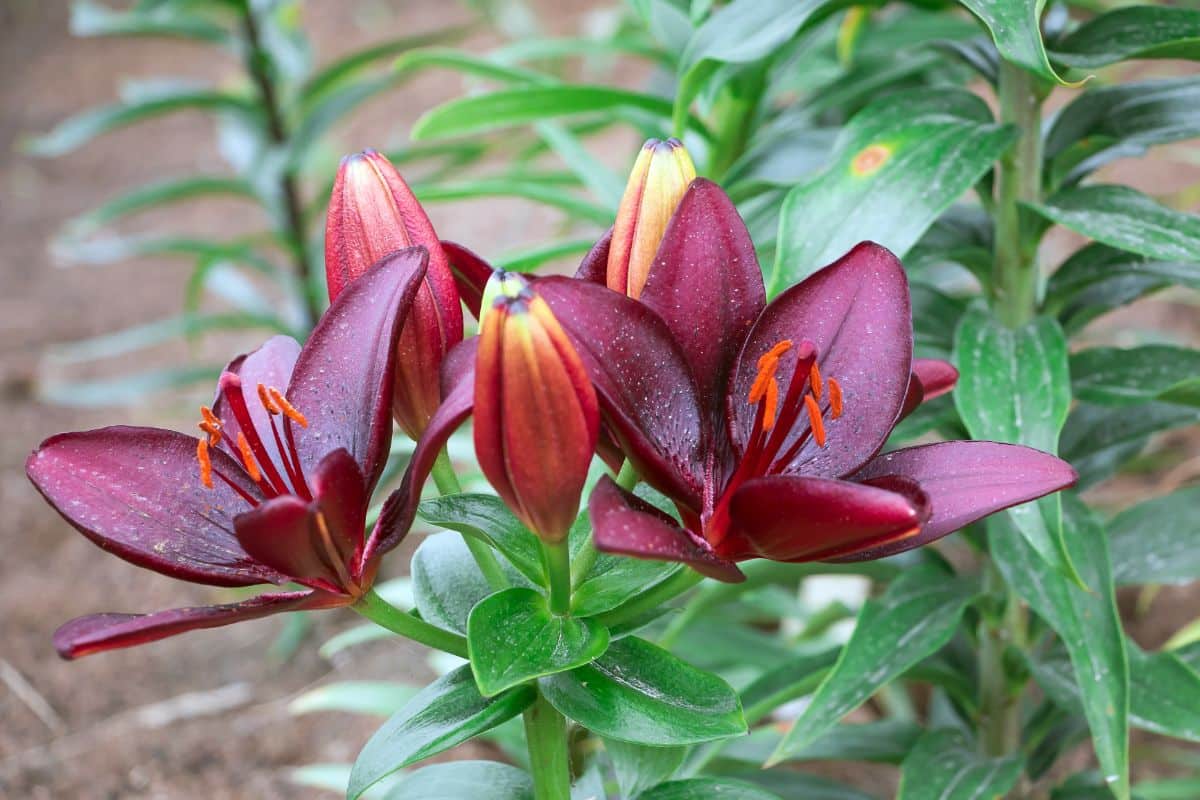
Lily blooms are fairly ephemeral. You can expect your lily plant to bloom for 2-3 weeks, and then it will be done until next season. Although deadheading is encouraged (more on that later), you should note that doing it will not promote a second bloom that same season.
For that reason, if you want to enjoy lilies for more than several weeks of the year, you should plant multiple varieties with different bloom times.
When to Plant True Lilies
Spring or fall are suitable seasons for planting lilies.
Ideal Growing Conditions for True Lilies
Regardless of the type of lily you are planting, your lilies are going to need to be in their ideal environments to do their best. Let’s go over the sun, water, and soil requirements for true lilies.
How Much Sun Do Lilies Need?
Your true lilies are going to thrive if they have plenty of sunlight. A sunny spot where they can get 6-8 hours of direct sunlight will be most suitable.
What Type of Soil is Right for Lilies?
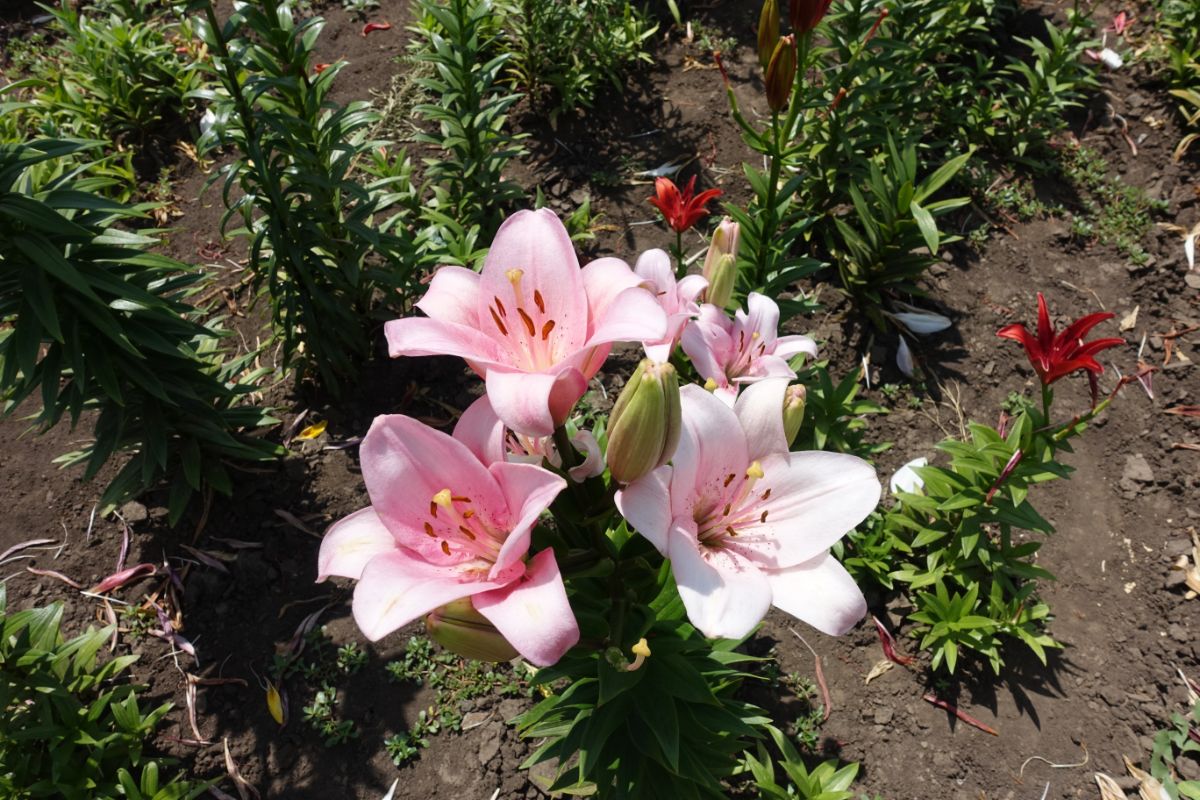
All soil types are fine for planting lilies. Whether you have clay soil, sandy soil, or anything in between, your lilies will be happy if the soil can drain. You should keep the soil moist but not let it get waterlogged. Damp conditions are not good for lilies.
Alkaline soil is not as ideal for lilies as acidic soil, so consider taking steps to make your soil more acidic if it needs it (see the section on planting for further directions).
How Much Water Do Lilies Need?
During the growing season, your lilies will need about an inch of water per week, as is the standard practice with the majority of garden perennials.
When rainfall is providing that inch of weekly water, you should not need to provide any additional water. But you can provide supplemental water during dry weeks.
How to Plant True Lilies
You can plant lilies in large containers or directly in your flower beds. Below, we go over step-by-step directions for both.
Ground Planting
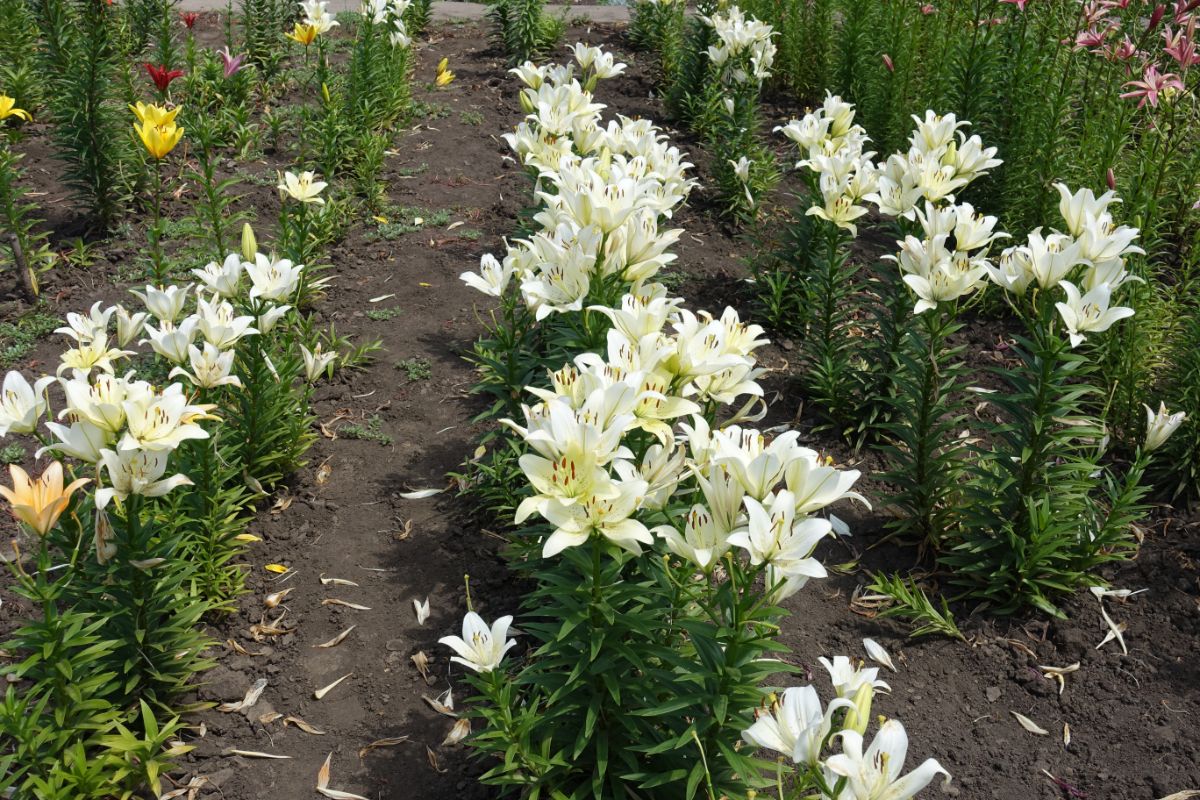
1. Pick a spot in your garden for your lilies and begin by prepping the soil. You should mix in compost, leaf mold, or another organic material.
Slightly acidic, well-drained soil is ideal for true lilies. If you do not already have acidic soil, there are various additives that can make your soil more acidic. If you already mixed in compost, then your soil should be more acidic than it was previously. The same goes for leaf mold. You probably will not need to do anything else to modify the pH before planting your lilies.
Mixing in compost has another benefit too, which is that it can help to ensure the excellent drainage your lilies will need.
2. Once you have mixed in your organic matter, you can make holes for your lily bulbs. Space them a couple of inches apart from each other.
3. Fill in the soil around the lily bulbs. The soil surface should cover all but the tips.
4. Water your lilies deeply.
Container Planting
1. If you want container-grown lilies, you need to begin by choosing appropriate pots. Lily containers need to be on the larger side, and drainage holes are a must.
2. Start filling the containers with potting mix. To get the right consistency for lilies, make sure about a third of the mixture is sand.
3. Place the lily bulbs inside the pots. Space apart the bulbs roughly 2 inches, so they each have plenty of room. The pointy part of each bulb should be facing upward so the roots can grow down into the soil.
4. Continue filling in the potting mix around and on top of the lily bulbs. You want only the very tips of the bulbs to be protruding above the potting mix.
5. For magnificent blooms, apply a slow-release fertilizer.
6. Water your freshly-planted lilies deeply.
How to Propagate True Lilies

Usually, you will grow true lilies from bulbs. But it is possible to grow them from seed. There are also a few different methods you can use for lily propagation.
Starting True Lilies from Seed
Let’s talk about how you can grow lilies from seeds. RHS Lily Group explains that it is easy to go overboard trying to figure out the timing but that “in practice, you can get good results simply by sowing the seeds as soon as you get them, and – at least in temperate climates such as most of the UK – letting the natural change of seasons do all the work of triggering germination.”
RHS Lily Group does add that early fall is an ideal time for sowing the seeds of North American lily plants. Let’s go over a brief form of the instructions.
1. Put some broken pieces of pots in the bases of your containers.
2. Fill your pots with seed compost, preferably lime-free. A combination of soil, grit, and pine bark works great.
3. Sow your lily seeds. Unlike the seeds for a lot of other plants, lily seeds are actually pretty big. That means that you can position each seed individually in an optimal way. They should go on top of the soil with the pointy ends downward. So, push them in a bit so they stay upright, but do not fully bury them at this time. Right now, you want to be focused on positioning them.
4. Now, you need to add a bit more of your potting mix to the top of the seeds. It should be approximately a centimeter thick. Pat it down gently, taking care that you will not push over the seeds. They will be covered, but they should remain in their upright positions.
Some extra grit can be helpful if you are expecting rain, as it will make it less likely that the rain will wash out the seeds.
5. Get a large container and fill it with water. Put the pot inside so that the water soaks up into the potting mix through the drainage holes on the bottom.
6. Remove the pot with your seeds from the container with water. Now, the water can drain from the potting mix.
7. Cover your pot with plastic wrap or a plastic lid, or even tie a plastic bag around it. Make sure that all the excess water has drained before you do this.
8. Find a cool location, such as a garage, for your containers with your lily seeds. It does not need to be dark, but it should not be in the bright sun either. Now and again, open up the plastic bags to make sure they are not drying out. Water as needed.
9. Wait for the lily plants to sprout. When they do, take off the plastic covering. Put the plants where they can get more light to help them grow.
Your lily seedlings will likely spend a couple of years in their original pots before you transplant them into larger containers or your garden beds.
Starting True Lilies from Bulblets, Bulbils, or Scales
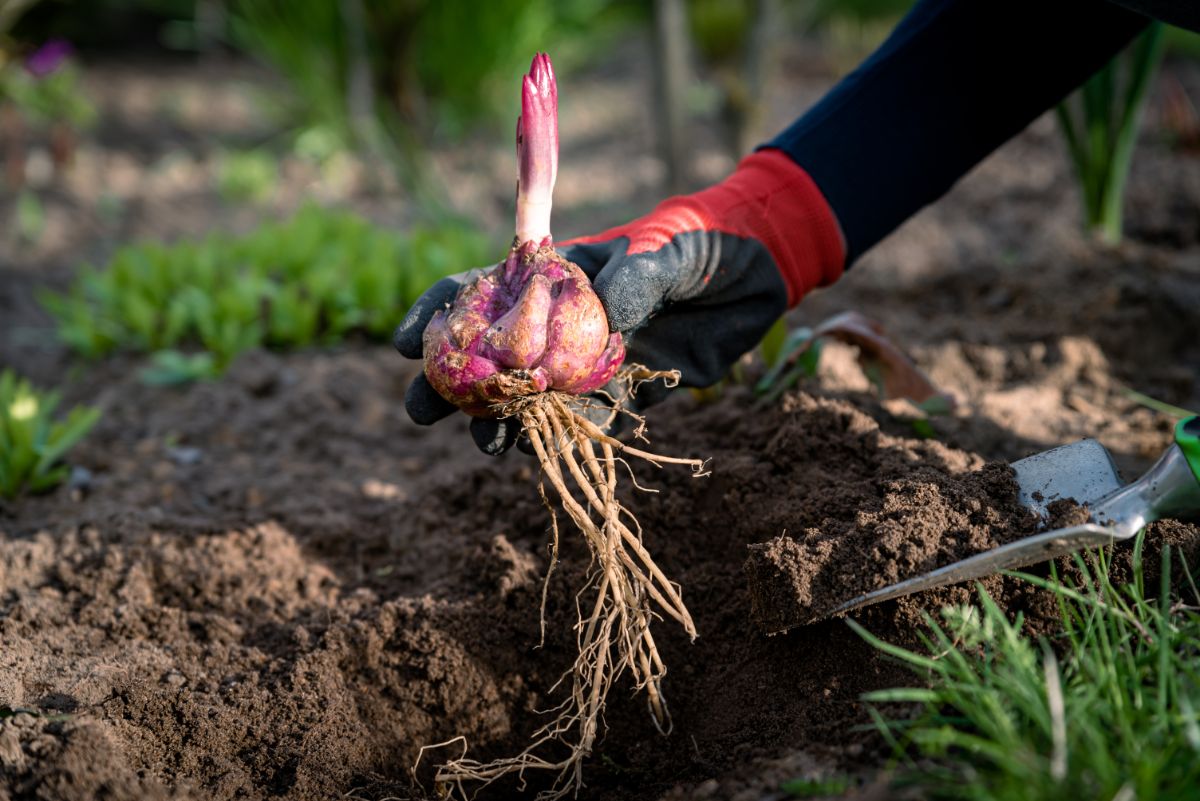
You have a number of possibilities for propagating lilies beyond seeds or divisions. One option is to do so using the bulblets, which you will find at the base of the stem. They will come with roots attached. A twisting motion while pulling by hand will separate them, after which you can transplant them.
There are also bulbils that are produced on the stems of lily plants. When summer draws to a close, you can separate them and transplant them.
Another option is propagation using scales. Gardening Australia writes, “Just grab the bulb and twist scales off sideways. Put rooting hormone in a bag, shake it up, and mix in some sphagnum moss. The moss should be premoistened so that it's not too wet but that when it's squeezed, no moisture comes out. Try using peat moss, shredded newspaper, or even vermiculite. Mix so that the scales are covered by moss and have some dampness, and then put them aside. In a couple of months, lovely little bulbs will be ready to plant out.”
How to Divide True Lilies
You can divide your lilies in the fall.
1. Use a trowel to dig down in a circle around your lily. Make sure you are digging sufficiently far from the bulb so that you do not damage your plant.
2. Pushing underneath the plant, pry it up from the ground.
3. You can now pull the bulbs apart to divide the plant into two or more smaller ones. You probably will be able to do this by hand.
4. Dig holes for the newly divided lilies and plant them. Backfill the soil and water well.
One thing to keep in mind is that it is easy for lily bulbs to dry out when they are sitting around out of the soil.
For that reason, you should delay as little as possible when it comes to transplanting them after division.
You may want to prepare the new holes in advance for just this reason. But should there be a delay for any reason, you can moisten some peat moss, put it in a plastic bag, and then place the bulbs inside. This will help them to stay hydrated until you are able to put them back in the ground.
How to Care for True Lilies
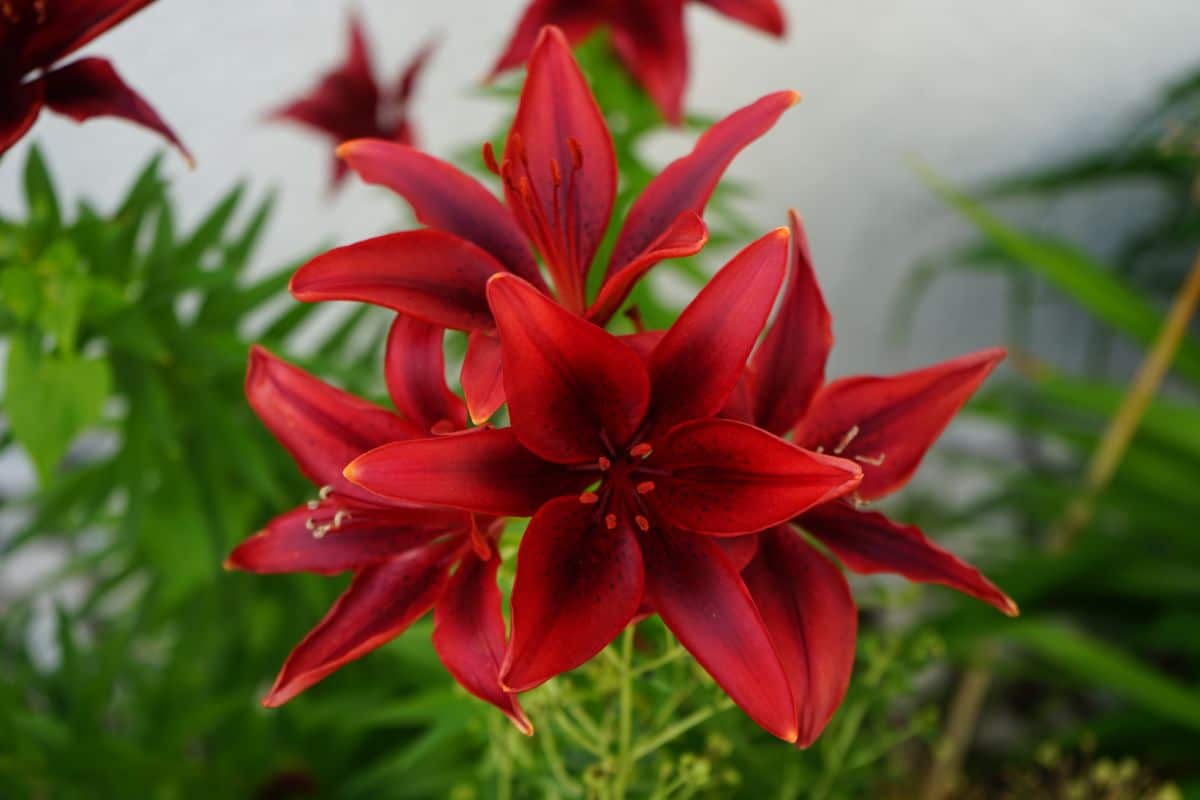
Now that you have learned how to plant and propagate lilies, you can find out how to keep them happy and thriving. In the sections below, we offer in-depth tips for fertilizing, staking, pruning, and mulching these beautiful plants.
How to Fertilize Lilies
It is a good idea to fertilize your true lilies. The North American Lily Society suggests, “Nitrogen is needed when the green leaves are growing rapidly, and phosphorus and potassium later for bloom and bulb production. A good all-around recipe would be to scratch in a generous helping of a complete formulation, such as 10-10-10 in early spring after the shoots have emerged, with smaller supplemental feedings throughout the season. Keep fertilizer from directly contacting the bulbs, and always water the fertilizer in thoroughly.”
How to Mulch Lilies
Lilies may benefit from mulch at different times of the year. During summer, mulch can help to lock moisture into the soil and keep it from getting too warm.
Another great way to help maintain moisture in the soil around your lilies is to use low-growing companion plants around them.
During fall and winter, mulch can provide useful insulation, protect the roots of the plants, and help prevent plants from getting too early a start each spring.
Keep in mind that means that when your plants are finally sprouting up at the start of each growing season, it is helpful to temporarily remove the mulch. But you need to be really careful when you are doing it so that you do not damage the plants.
What materials should you use for mulch for lilies? Some suitable options include pine needles, straws, leaves, or salt hay.
How to Stake Lilies
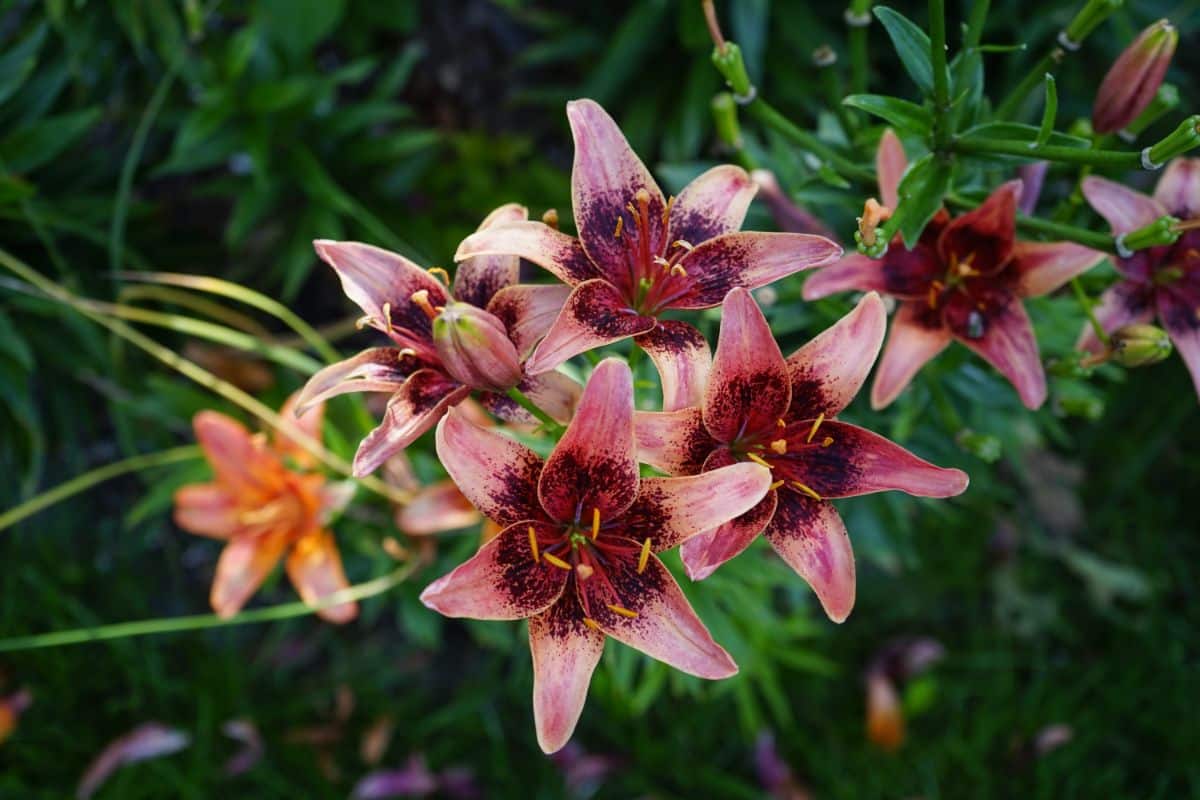
Not surprisingly, the heavy blooms of lilies can sometimes cause the tall stems to flop without support.
So, you may want to plant stakes before you plant your lilies. The reason to plant the stakes before the lilies is so you do not accidentally stab the bulbs.
What if you do not like the appearance of the stakes during the times when the lilies are not tall? If you cannot tolerate them, just plant little unobtrusive marker stakes first. Then plant the bulbs. Then, when the lilies are taller and need support, you can remove those little markers and drive in full-size support stakes. They shouldn’t harm the bulbs since you know where to push them in.
How to Prune Lilies
Pruning your lilies requires both deadheading and trimming if you want your plant to maintain optimal health and produce beautiful blooms year after year. Thankfully, you will discover it is incredibly fast and easy to take care of your true lilies’ pruning requirements.
How to Deadhead Lilies
Even though deadheading a lily will not allow it to bloom a second time during the same season, you will find that it is beneficial. It helps the plant start conserving energy to bloom the next year again. It can also tidy up the appearance of your lily.
Quoting another university, the University of Washington Botanic Gardens writes, “Once all the flowers have dropped their flower petals, it is a good idea to deadhead the stem, by cutting off the flower spike at the base, just above the stem leaves. Keep in mind that the leaves are the most important plant component to allow the lily to come back next year and flower even more than the year before. So, keep those leaves green and healthy all the rest of the summer and fall so they can help to store up food reserves for the winter and next year’s growth and flowering.”
When to Cut Back Lilies
As we discussed above, you should not trim back the leaves of your true lilies after they are done blooming, just the stems. But eventually, the leaves will die. That is when you can cut them back for winter. The plant will then be dormant until the next season.
Are True Lilies Vulnerable to Diseases or Pests?
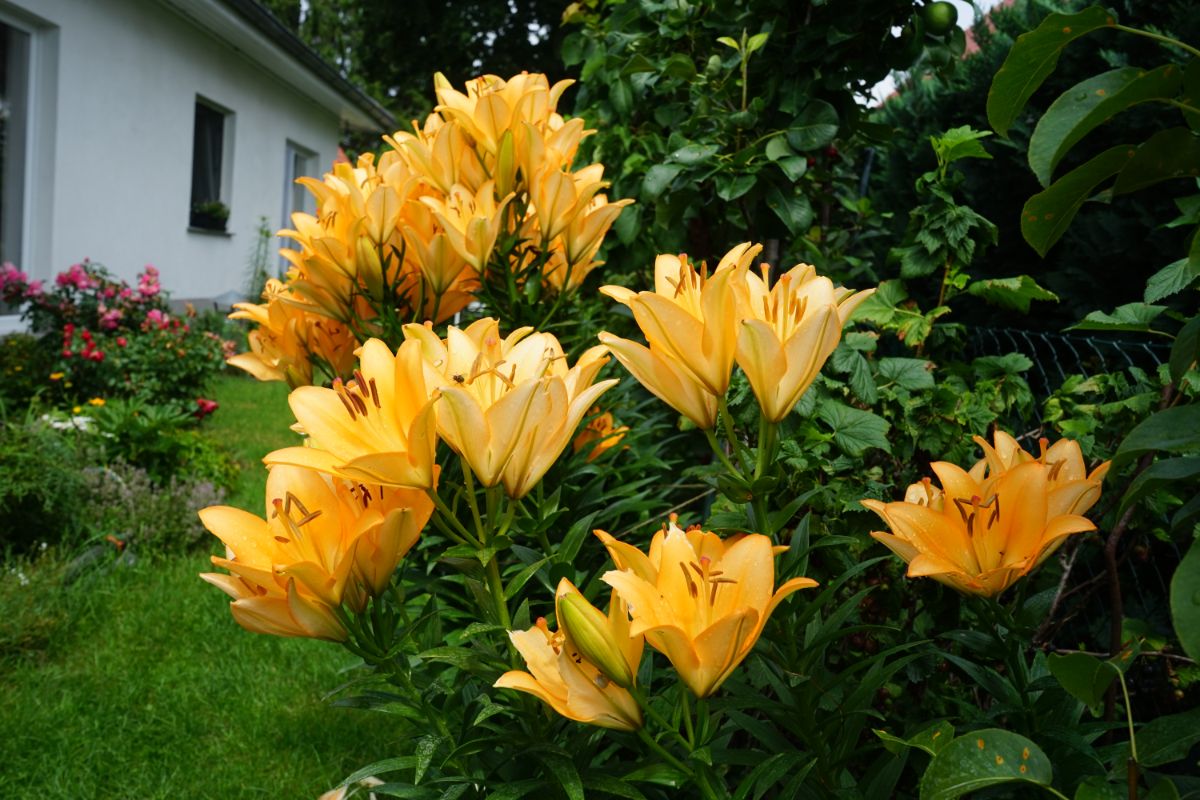
Let’s talk about some of the pests and diseases that can pose problems for lily flowers. These perennials can develop issues with gray mold, botrytis blight, and a variety of viruses.
The trick to avoiding mold is the same as it is with just about every other plant in your garden, and that is to keep your lilies’ feet from getting wet and also put space between them so that air can circulate.
As for how these fragrant flowers contract viruses, aphids are usually the culprit. So, if you notice an infestation of these pests, you are going to want to take prompt action since they will do damage both through their own behavior and through the diseases they spread.
Additional pests that can bother lilies include red lily beetles, snails, and slugs. Deer and rabbits may both try to eat lilies as well. It does seem that they are toxic to rabbits, but apparently not enough to deter them. So, you may sometimes need to take steps to keep these mammals out of your garden.
Recommended Planting Combinations for True Lily
Following are a few simple companion planting ideas for lilies:
• Pansies. These flowers have a low growth habit, so they can be a good choice for helping to keep the ground cool and moist where you plant your lilies. See our Pansies Full Growing Guide to learn how to plant and care for them.
• Allium. These bulb flowers bloom during late spring and into summer, making them a great companion for spring- and summer-blooming lilies.
• Roses. Since roses are shrubs, they can help to support floppy lilies. You might not need to rely on stakes as much as a result.
True Lily Landscaping Ideas
The most popular way to landscape with true lilies is to plant them in rows alongside paths or up against fences or walls.
Another idea for what you can do with true lilies is to plant them in containers or add them to a pollinator garden.
Recommended True Lily Varieties
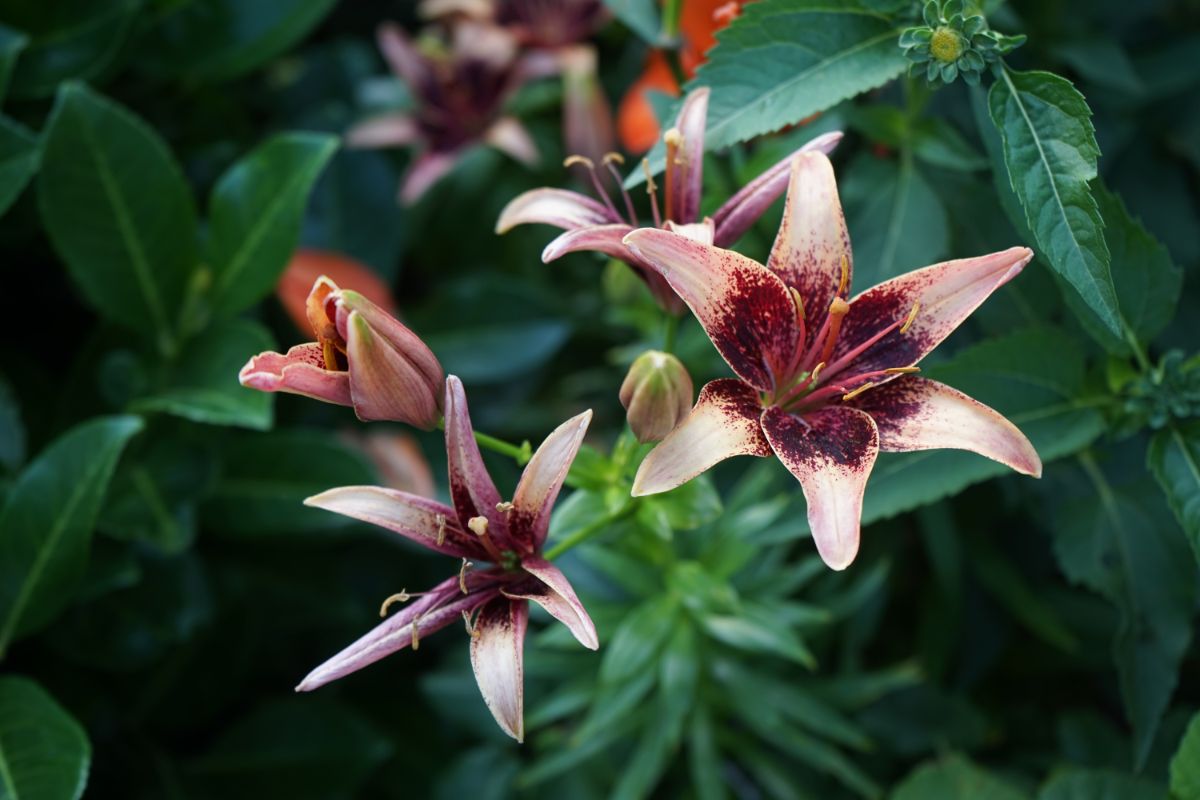
Whether you want pink flowers, white flowers, yellow flowers, or any others, you can find what you desire in the tremendous variety of true lilies. Below are some of our recommended cultivars.
• Starlette: These popular lilies will stun you with their red petals, fiery orange tips, and matching orange and speckled centers. You can look forward to them gracing your garden early in the summer.
• Night Rider: One of our favorite Asiatic hybrids is this one, which was made by crossing with a trumpet lily. The lily takes its name from the hue of its petals, which are a deep brownish-purplish color that, in certain light conditions, can appear black.
• Heartstrings: For a lily that really will pull at your heartstrings with its sheer beauty, consider this cultivar. The petals are a sunny yellow, blushing to a rosy pink at the tips.
• Henry’s Lily: This unusual perennial plant features orange blooms that include bumps on the petals. This texture makes it stand out from other lilies in your garden.
• Madonna Lily: Consider planting this lily if you are looking for beautiful white blooms.
• Fire Lily: This popular variety of lily has fiery orange petals that open in early summer. It is renowned for its delightful fragrance.
• Lily Sorbonne: This oriental variety of lily features bright pink petals with narrow white rims.
• Lily John Hancock: For bright yellow petals with brownish marks on them, plant this type of Asiatic lily.
• Tango Lily Pink Brush: You will adore the spackled pink petals of this unique cultivar of lily.
• Forza Red: If you want a lily that is a deep shade of red through and through, then consider getting this LA hybrid cultivar. Every part of the flower matches.
• Trumpet Lily African Queen: These trumpet blooms feature a beautiful gradient of hues from pink to orangey-yellow.
• Lily Lionheart: One type of lily that will catch anyone’s eye is this stunning and unusual cultivar. The petals are a dark brownish-reddish hue that is almost black. This color switches to bold yellow at the tips.
• Dark Secret: If you want a cultivar that produces darker blooms, then you will want to indulge yourself in the “Dark Secret” lily. The petals have a rich deep wine color that will make a statement in your garden.
• Distant Drum: It’s hard to guess why this plant is called “Distant Drum.” If anything, these lilies seem quite “loud,” albeit in a good way. They demand attention with their bright pink double blooms.
• Double Pink Oriental Rose: If you enjoy the look of the “Distant Drum” double lily but would prefer something that is a little more sedate, you might think about planting this cultivar instead. The petals are muted, pale pink instead of bright pink. A little light spackling near their centers adds to their delicate appearance.
• Polar Star: Another double lily variety that will make you gasp is the pristine white “Polar Star.” It is sure to become the star of your perennial garden.
• Playtime: With a name like this, you just know this cultivar is going to have a playful appearance. The blooms are white with streaks of bright yellow and pink, making for a vibrant and festive look.
• Asiatic Tango Lily London Heart: This lily has a truly distinctive appearance thanks to the unusual color combination on its petals. They are deep, dark reddish-purplish near the centers—almost black. But the outer half of each of the petals is bright red.
Remember to shop online for lilies if you want to find the biggest selection of Lilium plants.
Frequently Asked Questions About Growing True Lilies
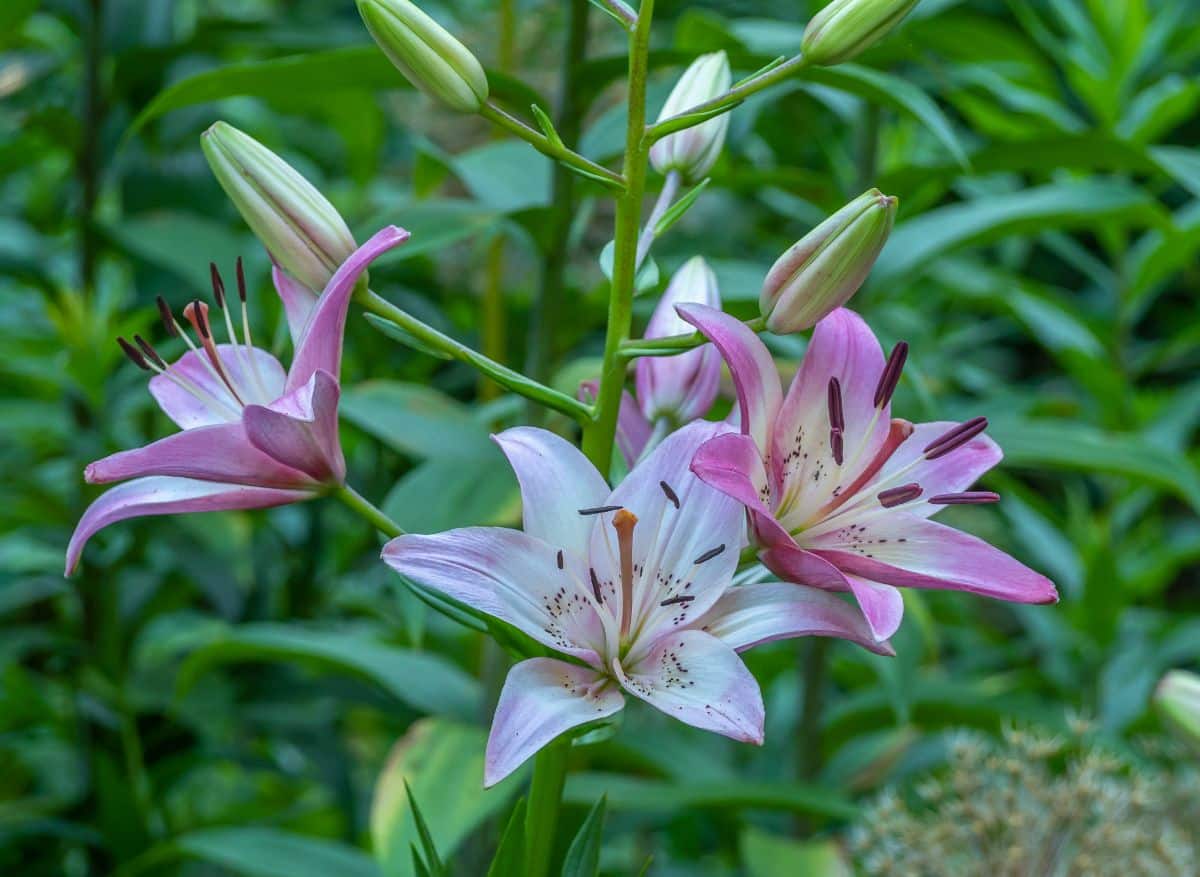
To wrap things up, let’s answer a few frequently asked questions about plants in the Lilium genus.
Certain insects eat true lilies, as do slugs, snails, rabbits, and deer.
Yes, true lilies are toxic to dogs and cats alike. We have seen mixed statements about this, but Chewy writes, “True lilies, including those of the Lilium or Hemerocallis species, are more likely to trigger acute kidney failure in cats and potentially similar problems for dogs.”
Keep your pet out of your lilies. If you do think your dog or cat ingested any amount of lily, you should seek immediate veterinary treatment for your pet.
True lilies are tall plants that feature large, dramatic blooms with petals that curve back.
Keep in mind that some other types of flowers that are referred to as “lilies” but which are not a part of the Lilium genus also have a similar appearance. So, it is easy to mix up true lilies with other types of lilies.
Lily plants are perennials in the zones where they are hardy. That means that with proper care, they can generally survive each winter to bloom the following year anew.
Where to Buy True Lilies
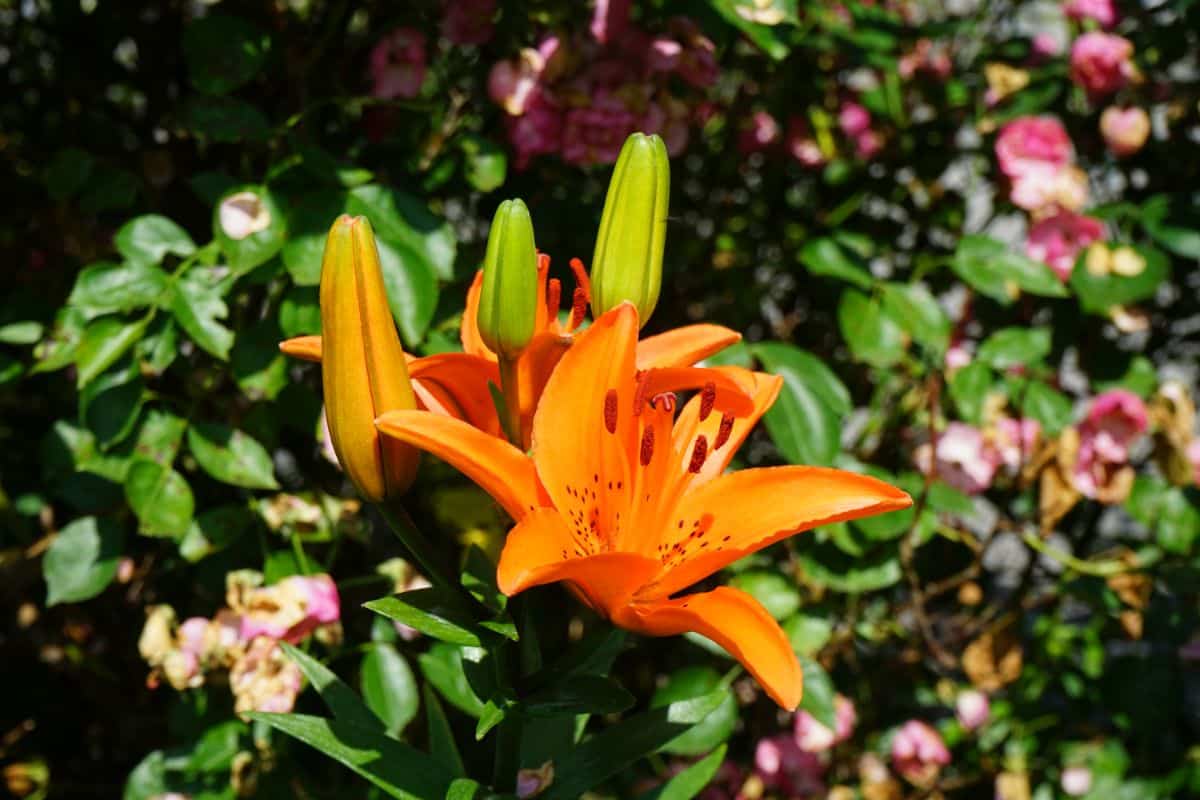
If you have fallen in love with the beauty of true lilies, you may be ready to try growing your own. The best way to find the largest variety of true lily cultivars is to shop for them online.









Leave a Reply